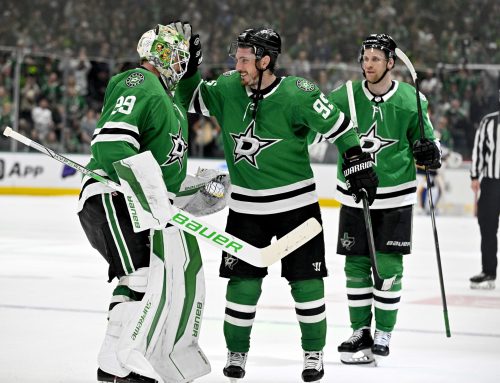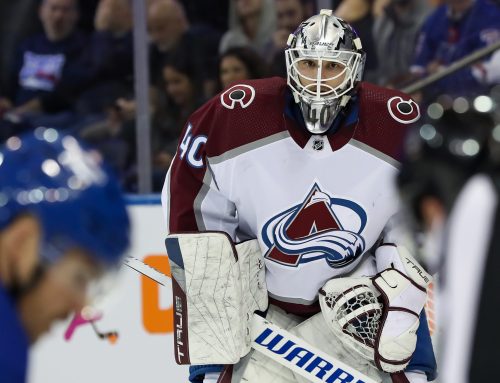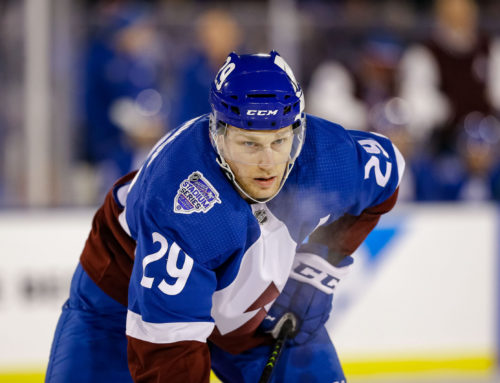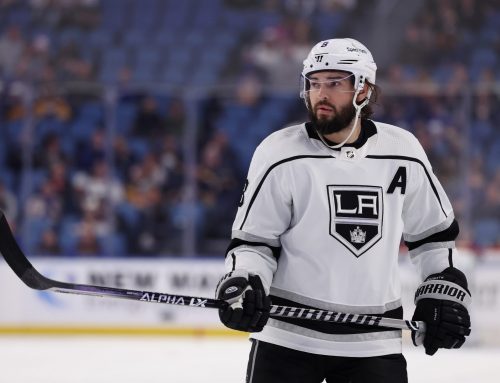West: 2016 Offseason Outlook – Minnesota and Los Angeles
Doran Libin
2016-05-23

The offseason fantasy hockey outlooks for the Minnesota Wild and the Los Angeles Kings…
Minnesota and Los Angeles
This week marks the first playoff teams to go under the microscope. Los Angeles and Minnesota are up as they finished lowest in the regular season standings of the teams eliminated in the first round. These teams are examples of two different approaches to playoff disappointment. Minnesota lost early and replaced their coach, albeit an interim coach, whereas Los Angeles lost and re-upped with Daryl Sutter. It is a lot easier for Los Angeles to stay with Sutter given the success they have had in recent years whereas Minnesota has failed to achieve consistent success. For Minnesota even though John Torchetti was relatively successful in turning the Wild around the opportunity to bring in one of the best coaches in the league marked an opportunity to take a giant leap forward. In this case the different approaches to playoff defeat come down to tinkering with success versus trying to find away to the next level.
Minnesota
Minnesota landed the big fish on the coaching market, which makes them a hard to analyze especially coming off a season that was a clear tale of two halves. It is tough to put a lot of stock into the fact that Minnesota got a little worse, or at best plateaued, offensively and look to have lost their way a little defensively. Bruce Boudreau likely was not hired to help the Wild find their way defensively again, although the Ducks were a good defensive team under his reign, but he should help them maximize their offensive potential especially with a ton of depth to draw from both up front and on the blue line. Given all the turmoil this past season and the changes this off season there does not seem to be much point in looking at how the Wild have been trending over the past few years. For fantasy purposes it makes more sense to look at what one can expect from a Boudreau team. Over the last three years the Ducks never finished with fewer than 29 shots per 60 minutes. The Ducks over that period have never had an expected goals per 60 under 2.7 whereas the Wild only reached 2.7 once in the last three years. The Ducks had the fourth highest aggregate expected goals per 60 minutes over the last three years in the NHL. This past year, even as the Ducks struggled to score they still created offense finishing with the 23rd highest expected goals per 60 of the last three years. All this is to shine a light on the ability of Bruce Boudreau to get his teams to generate offense, so even as the Wild do not have Getzlaf and Perry it is still safe to assume their offense will be much improved.
Before moving on to the offense a moment to look at the play of Devan Dubnyk. He showed nowhere close to the dominant form that was on display last season upon his arrival in Minnesota but he was at worst above average. Of goalies who played more than 50 games he had the 10th highest save percentage in the league. Basically Dubnyk was an average goalie, posting quality starts in 51.5% of his starts. If the Wild had been on their game defensively or offensively his being average would not have mattered nearly as much. Dubnyk was in fact basically the same goalie this year at even strength as he was last year but his shorthanded save percentage dropped by almost 10 points, that was enough to drop his overall save percentage by more than a full point. It is unlikely that Dubnyk will get back to posting a shorthanded save percentage over 90%, even if the Wild find the penalty killing magic the Ducks had this season, so a save percentage around 92% should be expected. Should Boudreau turn around the team’s offense Dubnyk’s fantasy value will rise along with the team’s fortunes.
The Wild have a very deep defense corps with Jonas Brodin arguably being the fifth defenseman. With Ryan Suter, Matt Dumba, Jared Spurgeon and Marco Scandella all getting more favorable usage than Brodin it will be tough for him to find much fantasy value, especially with Mike Reilly getting very sheltered offense-centric usage. The way Brodin is used might change but he it is hard to see him reclaiming power play minutes from the aforementioned four defensemen or even Mike Reilly. Ryan Suter’s usage will likely remain pretty similar to what it was in previous seasons if only because he plays so much and in all situations. The big factor for Suter is the power play, as his production is remarkably stable at even strength regardless of his percentage of secondary assists, IPP or shooting percentage. He struggles to hit 40 points if the power play struggles however the Boudreau tide should raise all ships. The defensemen to watch on this team are Jared Spurgeon and Matt Dumba. Spurgeon has twice been involved in less than 30% of the Wild’s even strength offense when he is on the ice and last year was one of those times, otherwise he is routinely around 32%. This dip was largely related to him only getting 11% of the assists while on the ice compared to routinely being around 25%. A return to his normal form in combination with his rising goal rate over the last two years could see Spurgeon come close to 40 points as well. Dumba is interesting because he could get the Sami Vatanen from treatment from Boudreau, as an offense first defenseman who gets lots of power play minutes. Last season he doubled his power play minutes and was very involved in the power play’s success, as he was involved in 78% of the goals scored when he was on the ice, without any secondary points.
The forward to watch on the Wild may be Jason Zucker as he had the eighth most minutes for the Wild amongst forwards despite taking the fifth most shots and having the third highest shots per 60 minutes. Two things held Zucker back last season the first is his low shooting percentage of just over eight percent and only getting three secondary assists of his 23 points. This is also partially due to him only getting 60 minutes of power play in his 71 games. He had some success with Mikko Koivu this year as they averaged 2.5 goals per 60 minutes, just below Koivu’s rate without him, but did a much better job of carrying the play. Chemistry like that should see Zucker find his way up the lineup.
Thomas Vanek was not all that bad this season but he definitely was not worth the contract the Wild are paying him, hence the talk about a potential buy out as they could save more than three million dollars this by doing so. Vanek was given every opportunity to succeed as he received the second most power play minutes but was unable to buck the trend in his career numbers. His shot rate and point rate have been trending down harshly in recent years as has his shooting percentage. Vanek just does not create offense in the way he used to and his departure could create big opportunities for some of the upcoming young forwards.
The Mikael Granlund, Zach Parise and Jason Pominville did not score much as they averaged less than two goals per 60 minutes as a line at even strength. That was not for lack of trying though as they generally carried the run of play, averaging 36 shots per 60 minutes, but only scoring on four percent of their shots. They were would have been a very dominant line if they could score but as it was their goals for per 60 minutes was less than of their expected goals for per 60. The only line to struggle to score more was the only line to generate more shots which was Granlund and Pominville with Nino Niederreiter in Parise’s place. To emphasize how snake bitten each of Granlund, Parise and Pominville were none of them managed to reach a seven percent on-ice shooting percentage. Under Boudreau this line could average 40 shots per 60 minutes and if they even scored on six percent of their shots when on the ice it could result in 10 to 15 more points for each of them.
There are not a lot of multi-category options on the Wild but Erik Haula could make some waves as a depth option. The late season checking line of him, Pominville and Niederreiter was quite dominant. They outshot their opposition by seven shots per 60 minutes while starting more than 30% of their shifts in the defensive zone often against prime competition. They could be potent as a checking similar to Kesler in Anaheim if Boudreau can find suitable options for to replace them in the top six.
Los Angeles
The Kings disappointed in the playoffs season but seemed to return to their dominant form of years past in the regular season. It is a bit of a misnomer though as there some disturbing trends that continued through this season. The offense definitely rebounded and looked more like it’s past self. They averaged a shot more than last season but went from 2.6 to 2.8 expected goals for per 60 minutes, which suggests that they not only were taking more shots but taking more dangerous shots. The offense however is not where the disturbing trends lie, it is on defense where they are going in the wrong direction. For the second straight year they allowed a shot more per 60 minutes than the year before. This goes to some of the problems that exist within the roster and is problematic because as they continue to allow increasingly more shots their ability to dictate the flow of the game diminishes.
With the Kings getting worse defensively over the last three years Jonathan Quick’s fantasy value has diminished. Quick is not an elite goalie, just look at his save percentage, just over league average 91.8%. Quick has only managed a save percentage above 92% once in his career otherwise he is basically an average goalie. The difference is his playoffs success has skewed the perception of his overall value and he has generally played on one of the best teams in the league, and behind one of the best defensive teams. The Kings are starting to feel the bite of a number of bad contracts and Quick is not at the level of goalie who can carry the team through the diminished roster.
The best evidence of the effect of the bad contracts on the Kings’ roster is on the defense corps. There are three very good defensemen in Drew Doughty, Jake Muzzin and Alec Martinez and a lot of question marks beyond them especially since Slava Voynov’s exit to Russia. Doughty, Muzzin and Martinez are the only three Kings defensemen to have received more than 50 minutes of power play time this season. With that distribution of ice time each is capable of putting up 40 points although Doughty and Muzzin are by far the most likely to do so as they generally receive first unit minutes. Doughty’s value got a major boost this season from the extra minutes he was asked to assume and hence he was able to break 50 points. If there is a defenseman on the Kings who might see a jump in value it is Brayden McNabb. He already received the fourth most minutes on back end with a similar assist rate to Martinez. Should he start to get a regular share of the power play time he could become a 25-30 point defenseman.
The Kings have a couple of albatross contracts up front in Marian Gaborik and Dustin Brown and with Kopitar getting a bump and Jeff Carter’s large contract they are going to have rely on cheaper depth players more than ever especially if they manage to re-sign Milan Lucic at a likely cap hit of close to six million. Should Lucic re-sign there are four definite top six forwards in Kopitar, Lucic, Carter and Toffoli but good luck figuring out who they will play with. There was only one forward combination on the Kings that played more than 400 minutes together this season for the Kings, which is a long way of saying that Sutter’s lines are constantly in the blender. That makes this a tough team to pick a player to succeed based on his linemates The secondary options for the top six are Gaborik, Brown and Tanner Pearson. Gaborik is the only one of the secondary top six options to have averaged more than a minute of power play time per game. This distribution of ice time in combination with the Kings’ already low scoring ways severely limits the number of fantasy relevant forwards on the Kings.
Gaborik and Brown had very similar seasons in terms of underwhelming production and some potentially promising underlying numbers. Both players had very low individual and on-ice shooting percentages which suggests that they are each in line for a major regression bump next season. That may not be the case for both of them though as each kicked their shot rate up significantly, both averaged individually more than 10 shots per 60 minutes. They did not however see a major bump in their respective expected goal rates. That suggests that they may not see as big of a regression bump as might otherwise be expected.
Tyler Toffoli would be the biggest beneficiary were Milan Lucic not to re-sign with the Kings. That may seem counter intuitive but the top power play unit was dominated by Lucic, Carter and Kopitar dominated. This meant that Toffoli was relegated to the second unit, which was basically purgatory until Vincent Lecavalier arrived late in the season. Toffoli had a bit of a weird season as his assist rate went down while his shooting percent took a giant leap. The net result was that he had a career season despite not laying on the top power play unit. Much of the jump in production despite contradictory underlying numbers can be attributed to his jump in playing time but it did result in him being involved in a much lower percentage of the offense than normal. That leaves open the potential for him to take another step forward this upcoming season.
Tanner Pearson would benefit in a big way from any significant, or even regular, top six minutes. Whereas Gaborik and Brown did not see the corresponding bump in their expected goals rates when they kicked up their shot rate Pearson actually saw his shot rate fall this past year while his expected goal rate rose. Expected goals is the number of goals a player could expect to score based on the shots that players has taken, therefore for his expected goal rate to rise as his shot rate fell that means he was getting much better scoring opportunities. With more time and better players Pearson should get even more of those opportunities and thus see a rise in his production rate.
| West: 2016 Offseason Outlook – Arizona and Colorado |
| West: 2016 Off-season Outlook: Calgary and Winnipeg |
| West: 2016 Off-season Outlook: Edmonton and Vancouver |
| Eastern Edge: Offseason Outlook for the Devils and Senators |
| Eastern Edge: Off-season Outlook for the Canadiens and Sabres |
| Eastern Edge – 2016 Offseason Outlook: Toronto and Columbus |





 NYR
NYR WSH
WSH FLA
FLA T.B
T.B WPG
WPG COL
COL VAN
VAN NSH
NSH EDM
EDM TOR
TOR CAR
CAR BOS
BOS VGK
VGK
